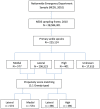Incidence and Cost of Ankle Sprains in United States Emergency Departments
- PMID: 27474161
- PMCID: PMC5089353
- DOI: 10.1177/1941738116659639
Incidence and Cost of Ankle Sprains in United States Emergency Departments
Abstract
Background: Ankle sprains represent a common injury in emergency departments, but little is known about common complications, procedures, and charges associated with ankle sprains in emergency departments.
Hypothesis: There will be a higher incidence of ankle sprains among younger populations (≤25 years old) and in female patients. Complications and procedures will differ between ankle sprain types. Lateral ankle sprains will have lower health care charges relative to medial and high ankle sprains.
Study design: Descriptive epidemiological study.
Level of evidence: Level 3.
Methods: A cross-sectional study of the 2010 Nationwide Emergency Department Sample was conducted. Outcomes such as charges, complications, and procedures were compared using propensity score matching between lateral and medial as well as lateral and high ankle sprains.
Results: The sample contained 225,114 ankle sprains. Female patients sustained more lateral ankle sprains (57%). After propensity score adjustment, lateral sprains incurred greater charges than medial ankle sprains (median [interquartile range], $1008 [$702-$1408] vs $914 [$741-$1108]; P < 0.01). Among complications, pain in the limb (1.92% vs 0.52%, P = 0.03), sprain of the foot (2.96% vs 0.70%, P < 0.01), and abrasion of the hip/leg (1.57% vs 0.35%, P = 0.03) were more common in lateral than medial ankle sprain events. Among procedures, medial ankle sprains were more likely to include diagnostic radiology (97.91% vs 83.62%, P < 0.01) and less likely to include medications than lateral ankle sprains (0.87% vs 2.79%, P < 0.01). Hospitalizations were more common following high ankle sprains than lateral ankle sprains (24 [6.06%] vs 1 [0.25%], P < 0.01).
Conclusion: Ankle sprain emergency department visits account for significant health care charges in the United States. Age- and sex-related differences persist among the types of ankle sprains.
Clinical relevance: The health care charges associated with ankle sprains indicate the need for additional preventive measures. There are age- and sex-related differences in the prevalence of ankle sprains that suggest these demographics may be risk factors for ankle sprains.
Keywords: Nationwide Emergency Department Sample; ankle; propensity score matching; sprains.
Conflict of interest statement
The authors report no potential conflicts of interest in the development and publication of this article.
Figures
References
-
- Beynnon BD, Vacek PM, Murphy D, Alosa D, Paller D. First-time inversion ankle ligament trauma: the effects of sex, level of competition, and sport on the incidence of injury. Am J Sports Med. 2005;33:1485-1491. - PubMed
-
- de Bie RA, de Vet HC, van den Wildenberg FA, Lenssen T, Knipschild PG. The prognosis of ankle sprains. Int J Sports Med. 1997;18:285-289. - PubMed
MeSH terms
LinkOut - more resources
Full Text Sources
Other Literature Sources
Medical
Research Materials


